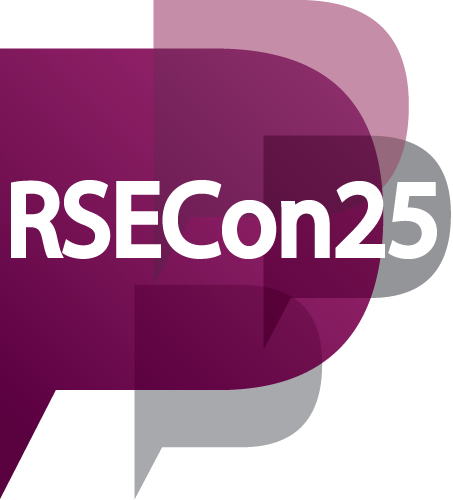Guidance for Talks and Interactives
All presenting authors will receive an email with technical details, guidance on how to upload materials and how questions will be handled. This is a bit different depending on what type of session you are presenting. This page gives general guidance on how to tailor your content to RSE Con 2025 and how to support your audience by making content accessible to all.
General guidance for all session types
When preparing slides and other content, please be mindful of the conference’s accessibility guidance.
Most talks and walkthroughs are in lecture-theatre rooms – so make sure to speak clearly to those at the back! Workshops and Birds-of-a-Feather (and a small number of talks) are in rooms with moveable tables – consider how you will arrange these to accommodate both in-person and hybrid attendees.
Hints when giving your talk
You should have been notified of the length of your talk (which may be different to the length you requested in your submission). Please remember that there is time allocated for questions like this:
- 15 minutes (10 for presentation with 5 for questions)
- 30 minutes (25 for presentation with 5 for questions)
- 45 minutes (40 for presentation with 5 for questions)
Your session chair will update you when you are reaching the end of your allocated time, but please help us out by aiming to keep to time!
Remember that we have a hybrid audience – this means trying to strike a good balance between the content visible on your slides and what you add in your spoken content. Don’t overload your slides, but try not to omit key details either!
While we encourage the use of colour and images to make engaging slides, do consider the accessibility guidelines and aim not to rely on these elements to convey any key part of your content.
Hints when delivering your interactive submission (Walkthrough, Workshop or BoF)
For Walkthroughs, the session chair will notify you when you are reaching the end of your time slot. Please be mindful of this! You may wish to take questions at the end of your presentation or throughout – make sure to inform the audience and to allow time for this in your planning! The session chair can support you in handling questions, but it is up to you to leave space for them.
For Workshops and BoF sessions, you will be chairing these yourself as presenters. How you wish to manage this is up to you. If you want guidance, as always please do contact the programme team as we’re happy to help with this.
For Workshops you may wish to consider how attendees could follow up if they continue to work on your content – can you offer to provide some support, or direct them to places which can?
For BoF sessions, how are you going to record any outcomes and development work from the session? Are you going to publish this somewhere? Will you disseminate beyond the attendees? If so, have you made this clear to participants how their contributions might be used?
Will attendees need additional information such as data, programs or document links? Full details on how to share this with participants are in your guidance email, but please do consider whether time will be needed to download or set up any content, and how you might manage this. If you need attendees to prepare before the session you may wish to contact the programme team to discuss the details.
Guidance on interpreting RSE work in our themes
For some ideas around how you may want to frame your talks around RSEs contribution to research excellence:
- Techniques – What techniques have you applied to research problems and what lessons did you learn that could be communicated helpfully to the RSE audience. Make sure the talk focuses on the technique and not the research.
- Note: The technique could be run-of-the-mill and still produce an outcome befitting of research excellence.
- Enabling methodology – What tools, methods, frameworks have you developed to better enable the research landscape, how are they innovative?
- Supporting others – How have you worked within a project to ensure that the project had a successful outcome that could otherwise have been out of scope.
- How we define and recognise excellence – What does RSE excellence look like and how do we apply this to career structures to get recognition from funders, institutions and other stakeholders. Also should we seek to define it?
- Developing yourself or others – Are you a new RSE working towards a goal, or a manager or mentor developing RSEs. Talk about your experiences developing RSEs and how this fits in a research excellence driven world.
- RSE Teaching and Learning – How do we apply best practices in teaching and learning to software training. How do we ensure that we deliver high quality teaching and learning? How do we measure learning? How do we design materials to a high standard?
For some ideas of how to interpret what you do as DRI (Digital Research Infrastructure):
- First let us define ‘things’
- Things: Software or hardware that could be considered research infrastructure
- Then we can say:
- I bodge things – It is notable that not all things work on or with all other things, The bodge of making two things stick together is thus a critical part of DRI.
- I make things – What do you make that is critical to research? How/is it recognised by anyone and what role does it play in the DRI?
- I maintain things – Computing is not static, hardware and software need ongoing maintenance. What role does RSE have in the upkeep of this kind of DRI?
